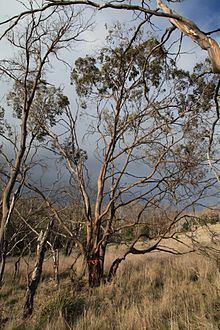Rank Species | Genus Eucalyptus Higher classification Gum trees | |
 | ||
Similar Gum trees, Eucalyptus cordata, Eucalyptus urnigera, Eucalyptus risdonii, Eucalyptus perriniana | ||
Eucalyptus morrisbyi is a rare and endangered tree species endemic to south-eastern Tasmania. Its common name is Morrisby's Gum. It has two natural populations on the eastern shore of the Derwent River valley. The limited range of E. morrisbyi means effective management is required to maintain or expand the distribution of this species.
Contents
Taxonomy
Eucalyptus morrisbyi belongs to the family Myrtaceae and genus Eucalyptus. It can be further classified as part of the sub-genus Symphyomyrtus and series Viminales. It is most closely related to E. gunnii and E. archeri, however these species do not occur within breeding range of E. morrisbyi.
Growth habit
Mature Eucalyptus morrisbyi individuals grow between 6 and 12 metres in height. The upper trunk has smooth bark of a light white-grey or pink-grey appearance. If drought stress or fire are severe, lignotuber reshoots may form a mallee growth habit. The species' juvenile leaves are rounded, unstalked and glaucous. The adult leaves are arranged alternately and are 5 to 10 cm long and 1.5 to 4 cm wide. They are stalked and less glaucous than the juveniles.
Reproduction
The flower buds arise from the leaf axils in groups of three and are glacous with a pointed operculum. The woody capsules have sunken valves and are approximately 10 mm long. Eucalyptus morrisbyi flowers between February and May and its medium of pollination are birds and insects. Recruitment occurs through canopy stored seed or vegetative reproduction from lignotubers.
Management
There are a number of management issues concerned with Eucalpytus morrisbyi due to its rarity. It is classed as endangered by both the Commonwealth Environmental Protection and Biodiversity Act 1999 and the Tasmanian Threatened Species Protection Act 1995. The two natural populations are assumed to be a remnant of a once larger range. The reduction in range can largely be attributed to land clearing after the arrival of Europeans to Tasmania.
